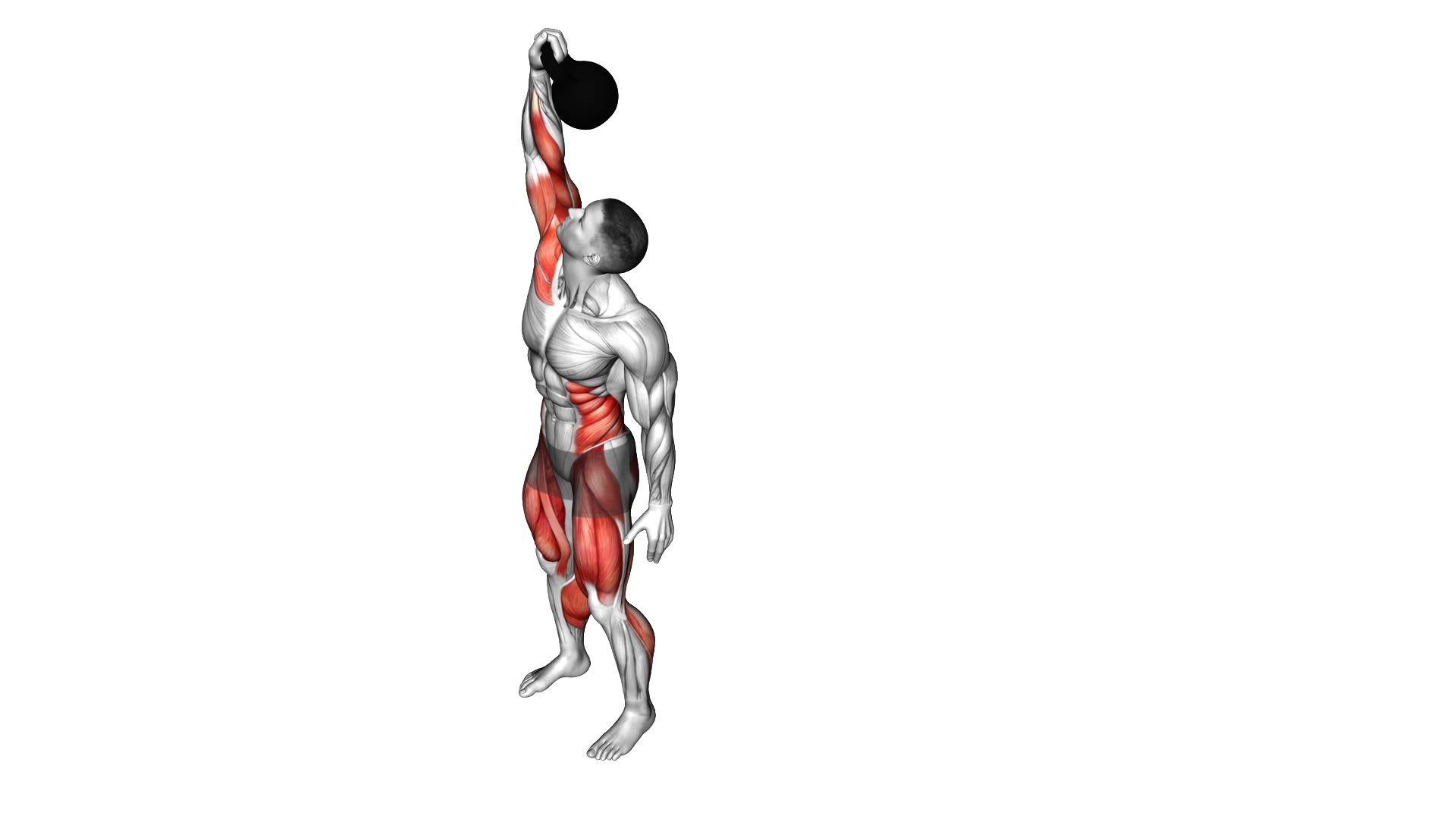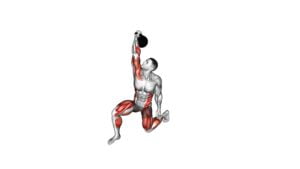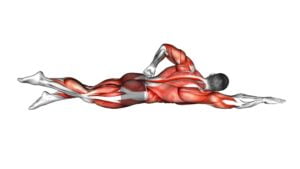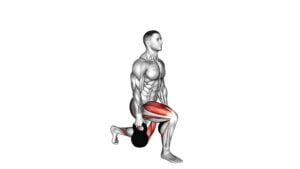Kettlebell Turkish Get-Up (Squat Style) – Video Exercise Guide & Tips

Are you looking for a challenging full-body exercise to add to your workout routine? Look no further than the Kettlebell Turkish Get-Up (Squat Style)!
Watch This Exercise Video
In this video exercise guide, we'll walk you through the step-by-step process of performing this dynamic movement. Not only will you learn the proper technique, but we'll also provide valuable tips to help you avoid common mistakes.
Get ready to level up your fitness game with this incredible exercise!
Key Takeaways
- Strengthens entire body in one exercise
- Improves balance and increases strength
- Engages multiple muscle groups simultaneously
- Enhances stability and control
Benefits of the Kettlebell Turkish Get-Up
One of the benefits of performing the Kettlebell Turkish Get-Up is that it strengthens your entire body in just one exercise. This exercise is highly effective at improving balance and increasing strength.
When you perform the Kettlebell Turkish Get-Up, you engage multiple muscle groups simultaneously, including your core, shoulders, legs, and glutes. As you move through the various stages of the exercise, your body must work together to maintain stability and control. This not only enhances your balance but also strengthens the muscles responsible for stabilizing your body.
Additionally, the Kettlebell Turkish Get-Up is a weight-bearing exercise, which means it puts stress on your bones and muscles, promoting bone density and muscle growth. By regularly incorporating this exercise into your workout routine, you can expect to see improvements in your overall strength and stability.
Remember to start with a light kettlebell and gradually increase the weight as you become more comfortable with the movement.
Equipment Needed for the Exercise
To perform the Kettlebell Turkish Get-Up, you'll need a kettlebell and a clear workout space. The kettlebell is the primary piece of equipment needed for this exercise. It's a round weight with a handle that comes in various sizes and weights. When choosing a kettlebell, it's important to select one that's appropriate for your fitness level and strength. It's recommended to start with a lighter kettlebell and gradually increase the weight as you become more comfortable with the exercise.
In addition to the kettlebell, you'll also need a clear workout space. This exercise requires you to move through various positions, so it's important to have enough room to perform the movements safely. Make sure there are no obstacles or objects that could potentially cause injury during the exercise.
Variations and modifications of the Kettlebell Turkish Get-Up can be done depending on your fitness level and any physical limitations you may have. For beginners, it's advisable to start with a lighter kettlebell and focus on mastering the proper form and technique before progressing to heavier weights. If you have any existing injuries or limitations, it's recommended to consult with a fitness professional or physical therapist for modifications that suit your specific needs.
Remember to always listen to your body and work within your capabilities to avoid injuries and maximize the benefits of this exercise.
Step-By-Step Guide to Performing the Kettlebell Turkish Get-Up
To successfully perform the Kettlebell Turkish Get-Up, it's crucial to focus on proper form and technique. This exercise offers a range of benefits including improved core strength, stability, and shoulder mobility.
However, to maximize your results, it's important to be aware of common mistakes to avoid.
Proper Form and Technique
To perform the Kettlebell Turkish Get-Up with proper form and technique, you need to start by lying on your back with the kettlebell placed above your shoulder. From there, you should bend your knee on the same side as the kettlebell, keeping your other leg straight. As you begin to roll onto your side, use your free hand to prop yourself up onto your forearm.
Next, push through your bent leg and raise your hips off the ground, coming into a kneeling position. Extend your back leg and stand up, keeping the kettlebell pressed overhead.
To complete the movement, reverse the steps and return to the starting position. Some common mistakes to avoid include not keeping the kettlebell directly above your shoulder and not maintaining proper alignment throughout the movement.
Modifications and variations can be made by using a lighter kettlebell or performing the exercise without any weight.
Benefits of This Exercise
Experience the numerous benefits of the Kettlebell Turkish Get-Up as you master the step-by-step guide for this exercise. Here are three reasons why you should incorporate this exercise into your workout routine:
- Muscle activation during the kettlebell Turkish get-up: This exercise engages multiple muscle groups, including the shoulders, core, hips, and legs. By performing the Turkish get-up, you can strengthen and tone these areas simultaneously, leading to improved overall strength and stability.
- Benefits of incorporating unilateral exercises into your workout routine: Unilateral exercises, like the Turkish get-up, focus on one side of the body at a time. This helps to identify and correct any muscle imbalances or weaknesses, leading to improved symmetry and functional strength.
- Improved functional fitness: The Kettlebell Turkish Get-Up is a complex movement that requires coordination, balance, and core stability. By mastering this exercise, you not only improve your strength but also enhance your ability to perform everyday activities, such as lifting objects or getting up from the ground.
By understanding the benefits of the Kettlebell Turkish Get-Up, you can maximize your workout routine and achieve optimal results.
Now, let's move on to the next section and learn about the common mistakes to avoid.
Common Mistakes to Avoid
To perform the Kettlebell Turkish Get-Up correctly and avoid common mistakes, you need to focus on maintaining proper form and alignment throughout each step of the exercise.
One common mistake isn't keeping your eyes on the kettlebell during the entire movement. By keeping your eyes on the kettlebell, you can ensure that your body stays aligned and that you maintain balance.
Another mistake is rushing through the exercise without proper control. Take your time with each step, focusing on the correct form and engaging the muscles properly.
Lastly, not using your core muscles enough can lead to incorrect form and potential injury. Make sure to engage your core throughout the entire exercise to maintain stability and control.
Common Mistakes to Avoid During the Exercise
When performing the Kettlebell Turkish Get-Up, make sure to avoid common mistakes that can hinder your progress and increase the risk of injury.
One mistake to avoid is keeping your elbows too bent throughout the movement, as this can put unnecessary strain on your joints.
Another common mistake is having an unstable shoulder position, which can lead to poor form and decreased stability.
Lastly, don't ignore engaging your core muscles throughout the exercise, as this is crucial for maintaining balance and stability.
Elbows Too Bent
If your elbows are too bent during the exercise, you may struggle to maintain proper form and stability. This can lead to a loss of balance and increase the risk of injury. Here are some tips to avoid this common mistake:
- Maintain a straight line: Make sure your wrists are stacked directly above your shoulders throughout the movement. This will help prevent unstable wrists and ensure proper alignment.
- Focus on shoulder mobility: Work on improving your shoulder mobility to allow for a full range of motion during the exercise. Tight shoulders can cause your elbows to bend, so incorporate exercises like shoulder stretches and mobility drills into your warm-up routine.
- Engage your core: A strong core is essential for maintaining stability during the Turkish Get-Up. Engage your core muscles throughout the exercise to help keep your elbows from bending excessively.
Unstable Shoulder Position
Avoid an unstable shoulder position during the Kettlebell Turkish Get-Up by maintaining proper form and stability. Shoulder stability is crucial to prevent injury during this exercise.
To ensure stability, start by lying on your back with your arm extended overhead, holding the kettlebell. As you begin to rise, keep your shoulder blades engaged and pulled down towards your back pockets. This will help maintain a stable shoulder position throughout the movement.
Avoid shrugging your shoulders or allowing them to roll forward, as this can lead to instability and potential injury.
Ignoring Core Engagement
Make sure to engage your core throughout the Kettlebell Turkish Get-Up to maximize the effectiveness of the exercise and prevent potential mistakes. Ignoring core engagement can lead to poor form and decreased benefits.
Here are three reasons why core activation is important during this exercise:
- Stability: Engaging your core provides a solid foundation for the movement, allowing you to maintain balance and control throughout the exercise.
- Injury prevention: A strong core helps protect your spine and reduces the risk of injury. By activating your core muscles, you provide support and stability to your entire body.
- Power transfer: The Turkish Get-Up requires a coordinated effort between your upper and lower body. By engaging your core, you enhance the transfer of force from your legs to your arms, resulting in more efficient movement and improved strength gains.
Modifications and Variations for Different Fitness Levels
Achieving optimal results in your kettlebell Turkish get-up routine requires tailoring the exercise to accommodate different fitness levels. By making modifications and progressions, you can ensure that each individual is able to safely and effectively perform the exercise while still challenging themselves.
For beginners or those with limited mobility, it's important to start with lighter kettlebells and focus on mastering the technique before adding weight. You can also modify the exercise by bending the knee of the non-working leg for added stability. As you progress, you can gradually increase the weight of the kettlebell and work towards performing the exercise without any modifications.
Intermediate and advanced individuals can further challenge themselves by incorporating variations into their routine. One variation is to perform the kettlebell Turkish get-up with an overhead press at the top of the movement. This adds an extra element of shoulder and core strength to the exercise. Another variation is to perform the get-up with a different style of kettlebell, such as a kettlebell with a thicker handle or a kettlebell with uneven weight distribution. These variations help to continually challenge and improve your strength and stability.
Tips for Incorporating the Kettlebell Turkish Get-Up Into Your Workout Routine
Incorporate the kettlebell Turkish get-up into your workout routine for a challenging full-body exercise. This movement not only strengthens your muscles but also improves your stability, mobility, and coordination. Here are some tips to help you incorporate kettlebell Turkish get-ups into your workout routine effectively:
- Start with a light kettlebell: Since the Turkish get-up is a complex exercise that requires a lot of stability and control, it's important to start with a lighter kettlebell to perfect your form before increasing the weight.
- Practice proper form: Take the time to learn and understand the correct technique for each step of the Turkish get-up. This will help you avoid injury and ensure that you're getting the most out of the exercise.
- Include it as a warm-up or finisher: You can incorporate kettlebell Turkish get-ups into your workout routine either as a dynamic warm-up exercise to activate your entire body or as a challenging finisher to really fatigue your muscles.
Frequently Asked Questions
How Many Calories Does the Kettlebell Turkish Get-Up Burn?
When you perform the Kettlebell Turkish Get-Up, you can expect to burn a significant amount of calories. This exercise engages multiple muscle groups and requires a lot of energy. The exact number of calories burned will vary depending on factors like your weight and intensity.
However, using a kettlebell adds resistance and increases the calorie burn. If you're looking for an alternative weight, you can try using a dumbbell or a sandbag to still get a challenging workout.
Can the Kettlebell Turkish Get-Up Help Improve Stability and Balance?
Improving stability and balance is crucial for your overall fitness. The Kettlebell Turkish Get-Up can be a great way to achieve this.
By incorporating this exercise into your routine, you won't only strengthen your core but also increase shoulder mobility. This exercise requires you to maintain control and balance throughout the movement, challenging your stability.
With practice and consistency, you'll notice improvements in your overall stability and balance.
Is It Necessary to Use a Kettlebell for the Turkish Get-Up, or Can Other Weights Be Used?
Yes, other weights can be used for the Turkish Get Up. While the kettlebell is commonly used, you can also use dumbbells or even a barbell.
The key is to choose a weight that challenges you but still allows you to maintain proper form and control.
Are There Any Specific Warm-Up Exercises Recommended Before Performing the Kettlebell Turkish Get-Up?
Before performing the kettlebell Turkish get-up, it's important to warm up properly. Specific warm-up exercises help prepare your body for the movement and reduce the risk of injury.
Incorporating dynamic stretches, such as arm circles and hip swings, can increase mobility and flexibility. Additionally, performing bodyweight exercises like lunges and squats can activate the muscles you'll be using during the get-up.
This warm-up routine is beneficial for athletes as it enhances overall performance and stability.
Can the Kettlebell Turkish Get-Up Be Beneficial for Individuals With Lower Back Pain or Injuries?
Lower back pain or injuries can be challenging, but the kettlebell Turkish get-up can actually be beneficial for you. This exercise helps strengthen your lower back muscles, improving stability and reducing pain.
However, if you're experiencing discomfort, it's crucial to consult with a healthcare professional. They may recommend alternative exercises for lower back pain, such as glute bridges or bird dogs.
Remember to start with lighter weights and focus on proper form to avoid exacerbating your condition.
Conclusion
In conclusion, the kettlebell Turkish get-up is a highly beneficial exercise that targets various muscle groups and improves core strength, stability, and mobility.
By following the step-by-step guide and avoiding common mistakes, you can effectively perform this exercise.
Additionally, modifications and variations allow individuals of different fitness levels to incorporate the Turkish get-up into their workout routine.
Remember to start with a lighter kettlebell and gradually increase the weight as you become more comfortable and proficient in the movement.

Author
Years ago, the spark of my life’s passion ignited in my mind the moment I stepped into the local gym for the first time. The inaugural bead of perspiration, the initial endeavor, the very first surge of endorphins, and a sense of pride that washed over me post-workout marked the beginning of my deep-seated interest in strength sports, fitness, and sports nutrition. This very curiosity blossomed rapidly into a profound fascination, propelling me to earn a Master’s degree in Physical Education from the Academy of Physical Education in Krakow, followed by a Sports Manager diploma from the Jagiellonian University. My journey of growth led me to gain more specialized qualifications, such as being a certified personal trainer with a focus on sports dietetics, a lifeguard, and an instructor for wellness and corrective gymnastics. Theoretical knowledge paired seamlessly with practical experience, reinforcing my belief that the transformation of individuals under my guidance was also a reflection of my personal growth. This belief holds true even today. Each day, I strive to push the boundaries and explore new realms. These realms gently elevate me to greater heights. The unique combination of passion for my field and the continuous quest for growth fuels my drive to break new ground.







